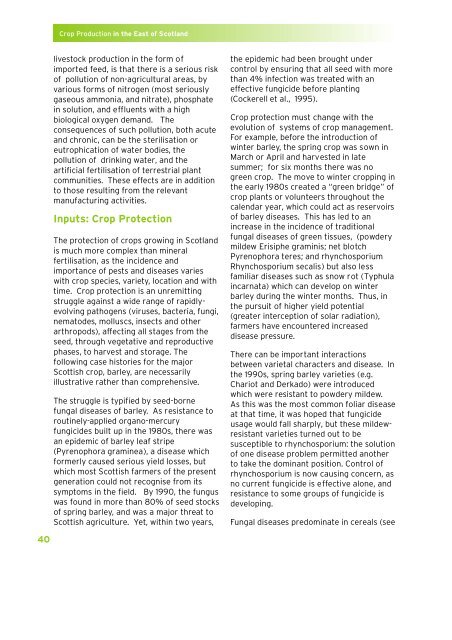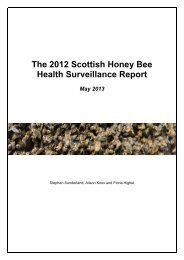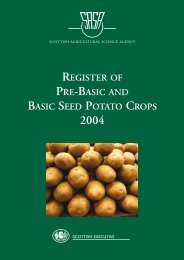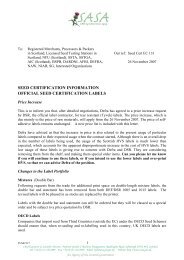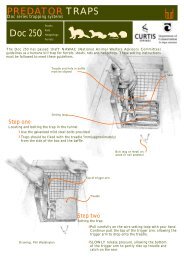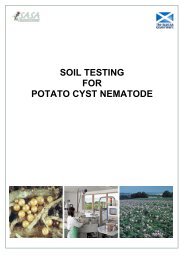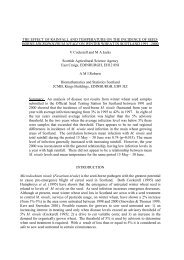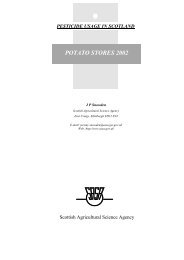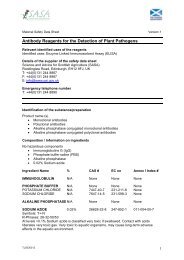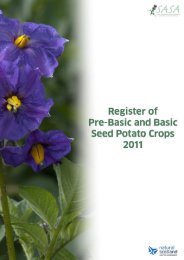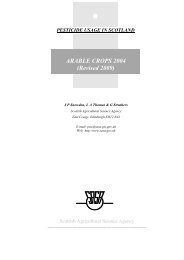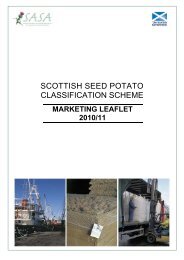You also want an ePaper? Increase the reach of your titles
YUMPU automatically turns print PDFs into web optimized ePapers that Google loves.
<strong>Crop</strong> <strong>Production</strong> <strong>in</strong> <strong>the</strong> <strong>East</strong> <strong>of</strong> <strong>Scotland</strong>livestock production <strong>in</strong> <strong>the</strong> form <strong>of</strong>imported feed, is that <strong>the</strong>re is a serious risk<strong>of</strong> pollution <strong>of</strong> non-agricultural areas, byvarious forms <strong>of</strong> nitrogen (most seriouslygaseous ammonia, and nitrate), phosphate<strong>in</strong> solution, and effluents with a highbiological oxygen demand. Theconsequences <strong>of</strong> such pollution, both acuteand chronic, can be <strong>the</strong> sterilisation oreutrophication <strong>of</strong> water bodies, <strong>the</strong>pollution <strong>of</strong> dr<strong>in</strong>k<strong>in</strong>g water, and <strong>the</strong>artificial fertilisation <strong>of</strong> terrestrial plantcommunities. These effects are <strong>in</strong> additionto those result<strong>in</strong>g from <strong>the</strong> relevantmanufactur<strong>in</strong>g activities.Inputs: <strong>Crop</strong> ProtectionThe protection <strong>of</strong> crops grow<strong>in</strong>g <strong>in</strong> <strong>Scotland</strong>is much more complex than m<strong>in</strong>eralfertilisation, as <strong>the</strong> <strong>in</strong>cidence andimportance <strong>of</strong> pests and diseases varieswith crop species, variety, location and withtime. <strong>Crop</strong> protection is an unremitt<strong>in</strong>gstruggle aga<strong>in</strong>st a wide range <strong>of</strong> rapidlyevolv<strong>in</strong>gpathogens (viruses, bacteria, fungi,nematodes, molluscs, <strong>in</strong>sects and o<strong>the</strong>rarthropods), affect<strong>in</strong>g all stages from <strong>the</strong>seed, through vegetative and reproductivephases, to harvest and storage. Thefollow<strong>in</strong>g case histories for <strong>the</strong> majorScottish crop, barley, are necessarilyillustrative ra<strong>the</strong>r than comprehensive.The struggle is typified by seed-bornefungal diseases <strong>of</strong> barley. As resistance torout<strong>in</strong>ely-applied organo-mercuryfungicides built up <strong>in</strong> <strong>the</strong> 1980s, <strong>the</strong>re wasan epidemic <strong>of</strong> barley leaf stripe(Pyrenophora gram<strong>in</strong>ea), a disease whichformerly caused serious yield losses, butwhich most Scottish farmers <strong>of</strong> <strong>the</strong> presentgeneration could not recognise from itssymptoms <strong>in</strong> <strong>the</strong> field. By 1990, <strong>the</strong> funguswas found <strong>in</strong> more than 80% <strong>of</strong> seed stocks<strong>of</strong> spr<strong>in</strong>g barley, and was a major threat toScottish agriculture. Yet, with<strong>in</strong> two years,<strong>the</strong> epidemic had been brought undercontrol by ensur<strong>in</strong>g that all seed with morethan 4% <strong>in</strong>fection was treated with aneffective fungicide before plant<strong>in</strong>g(Cockerell et al., 1995).<strong>Crop</strong> protection must change with <strong>the</strong>evolution <strong>of</strong> systems <strong>of</strong> crop management.For example, before <strong>the</strong> <strong>in</strong>troduction <strong>of</strong>w<strong>in</strong>ter barley, <strong>the</strong> spr<strong>in</strong>g crop was sown <strong>in</strong>March or April and harvested <strong>in</strong> latesummer; for six months <strong>the</strong>re was nogreen crop. The move to w<strong>in</strong>ter cropp<strong>in</strong>g <strong>in</strong><strong>the</strong> early 1980s created a “green bridge” <strong>of</strong>crop plants or volunteers throughout <strong>the</strong>calendar year, which could act as reservoirs<strong>of</strong> barley diseases. This has led to an<strong>in</strong>crease <strong>in</strong> <strong>the</strong> <strong>in</strong>cidence <strong>of</strong> traditionalfungal diseases <strong>of</strong> green tissues, (powderymildew Erisiphe gram<strong>in</strong>is; net blotchPyrenophora teres; and rhynchosporiumRhynchosporium secalis) but also lessfamiliar diseases such as snow rot (Typhula<strong>in</strong>carnata) which can develop on w<strong>in</strong>terbarley dur<strong>in</strong>g <strong>the</strong> w<strong>in</strong>ter months. Thus, <strong>in</strong><strong>the</strong> pursuit <strong>of</strong> higher yield potential(greater <strong>in</strong>terception <strong>of</strong> solar radiation),farmers have encountered <strong>in</strong>creaseddisease pressure.There can be important <strong>in</strong>teractionsbetween varietal characters and disease. In<strong>the</strong> 1990s, spr<strong>in</strong>g barley varieties (e.g.Chariot and Derkado) were <strong>in</strong>troducedwhich were resistant to powdery mildew.As this was <strong>the</strong> most common foliar diseaseat that time, it was hoped that fungicideusage would fall sharply, but <strong>the</strong>se mildewresistantvarieties turned out to besusceptible to rhynchosporium: <strong>the</strong> solution<strong>of</strong> one disease problem permitted ano<strong>the</strong>rto take <strong>the</strong> dom<strong>in</strong>ant position. Control <strong>of</strong>rhynchosporium is now caus<strong>in</strong>g concern, asno current fungicide is effective alone, andresistance to some groups <strong>of</strong> fungicide isdevelop<strong>in</strong>g.Fungal diseases predom<strong>in</strong>ate <strong>in</strong> cereals (see40


